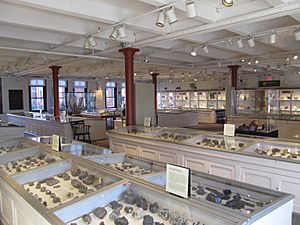Harvard Mineralogical Museum facts for kids
The Harvard Mineralogical Museum is a super cool place where you can explore amazing rocks, minerals, and fossils! It's officially called the Mineralogical and Geological Museum at Harvard (MGMH). This museum is part of the famous Harvard University in Cambridge, Massachusetts. It's also one of the three research museums that make up the Harvard Museum of Natural History. Imagine a giant collection of Earth's treasures, all in one spot!
How the Museum Started
The story of this museum began a long time ago. In 1859, a Harvard professor named Louis Agassiz helped build the University Museum. He wanted a place to keep his collection of animals. But soon, the museum started collecting other natural science items too, like rocks and minerals.
In 1901, Louis Agassiz's son, Alexander Agassiz, officially created a separate Geological Museum. This museum focused on Earth's history and rocks. Later, in 1966, the Mineralogical Museum (which had started on its own) joined with the Geological Museum. That's how the Harvard Mineralogical Museum we know today was formed!
What You Can See: The Collection
The Harvard Mineralogical Museum has the oldest university collection of its kind in the United States. It was started way back in 1784 by Benjamin Waterhouse. He was a professor at Harvard Medical School.
When it first began, the collection had about 1,600 specimens. That's a lot of rocks and minerals! But guess what? Today, the museum holds an incredible 400,000 specimens. That's a huge number of unique rocks, sparkling crystals, and ancient fossils waiting to be discovered. It's like a giant treasure chest filled with Earth's natural wonders!


